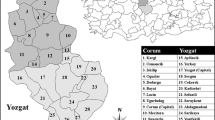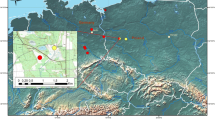Abstract
Argas neghmei Kohls & Hoogstraal is a Neotropical tick species parasite of poultry and man in the arid western of the southern cone of America in Argentina and Chile. Males, females and nymphs of an argasid were collected from 20 to 22 of June, 2007 in nests of Creamy-breasted Canastero, Asthenes dorbignyi (Reinchenbach) (Passeriformes: Furnariidae) at about 7 km S of La Poma (24°46′S, 66°12′W) and a male tick at 24°48′S, 66°10′W on Nov 27, 2008, Salta province, Argentina. Scanning electron microscope micrographies and sequences of 16S rDNA confirmed that the ticks found were A. neghmei. Development in breeding areas of A. dorbignyi is probably a source of infestation for animal premises and houses. However, the role of other unknown wild birds may also contribute to the invasion of A. neghmei in chicken houses or residences.
Similar content being viewed by others
Avoid common mistakes on your manuscript.
Introduction
Argas neghmei Kohls & Hoogstraal, 1961 is a Neotropical tick species found in the arid northern Chile and western Argentina. Known hosts for this tick species are restricted to domestic fowl and man, accordingly it has been also found in chicken houses and residences (González-Acuña and Guglielmone 2005; Guglielmone and Nava 2005). Aguirre et al. (1997) reported severe erythema, pruritus, and skin discoloration on humans bitten by A. neghmei in the Andean High Plateau in Argentina but there is no information about its capacity to distress avian hosts.
As stated above, A. neghmei is a Neotropical tick species but domestic fowl are introduced to this Zoogeographic Region. Consequently, the original hosts for this tick species are unknown. Indeed, the presence of A. neghmei on poultry, man and their surroundings indicates a capacity of this species to colonize additional niches from a wild undetermined habitat but there are no cues to understand the origin of this argasid able to colonize premises. Information on a wild host for A. neghmei has been obtained recently and the results are presented thereafter.
Materials and methods
Ticks of the genus Argas were collected when analyzing the fauna contained in 15 active nests of Creamy-breasted Canastero, Asthenes dorbignyi (Reinchenbach) (Passeriformes: Furnariidae) collected from 20 to 22 of June, 2007 in Campo Negro at about 7 km S of La Poma (24°46′S, 66°12′W) Salta province, Argentina. At the moment of collection these nests were non inhabited (i.e. mating pairs and/or nestlings were not observed inside the nests) and all were situated on columnar cacti, Trichocereus atacamensis (Phil.) Backeb. Another tick was found at 24º 48′S, 66º 10′W on Nov 27, 2008 from seven nests. Four nests of A. dorbignyi from Tucumán: Cuesta de los Cardones, 2,900 m, 3-VI-2009 were also inspected. Activity on these nests was confirmed by the presence of the birds or its eggs. Scanning electron microscope (SEM) micrographies were obtained for a male and a female tick collected in 2007. DNA was extracted to the female tick collected in 2008 to obtain a sequence of the 16S rDNA following Mangold et al. (1998). Keys and descriptions for Neotropical Argas, especially the information presented by Keirans et al. (1979) and the description contained in Kohls & Hoogstraal (1961) were used to identify the specimens by comparison of SEM. The sequences of 16S rDNA were matched with the sequences for Argas species deposited in the GenBank.
Ticks specimens were deposited in the tick collection of the Instituto Nacional de Tecnología Agropecuaria (INTA), Estación Experimental Agropecuaria Rafaela, Rafaela, Santa Fe, Argentina, under accession INTA2014, INTA2015 and INTA2016; specimens for DNA extraction and SEM correspond to INTA2083.
Results
Of the fifteen nests of A. dorbignyi from Campo Negro searched for ticks in 2007 only five nests were infested: 20-VI-07, 1 ex. (nest # 1), 1 ex. (nest # 4), 6 exx. (nest # 6), 21-VI-07, 6 exx. (nest # 12–13), 22-VI-07, 12 exx. (nest # 15). We inspected 8 males, 3 females and 9 nymphs. Of the seven nests inspected in 2008 only one contains a female tick, and the nests from Tucumán were negative for A. neghmei. All adult ticks were characterized by a peripheral striated area with Argas persicus-like cells (quadrangular or subquadrangular cells with a large pit and a small seta each), few lateral ribs and dorsal ridges short; tarsi I–IV each with notorious dorsal subapical protuberance are peculiar to A. neghmei according to Keirans et al. (1979) (Fig. 1). The ticks coincided also with the description of A. neghmei reported by Kohls & Hoogstraal (1961). Besides, the 16S DNA sequence obtained (GenBank accession number FJ853598) has a concordance of 100% with the GenBank sequence DQ295781 of A. neghmei from Chile, further confirming the diagnosis based on morphological features.
Discussion
Argas neghmei has been found in the west of southern South America Cone in Argentina and Chile. The wild bird A. dorbignyi breeds in the northern Chile, northwestern Argentina, southern Peru and southwestern Bolivia at an altitude range from 1,800 to 4,800 m (Martínez and González 2004) which matches the altitude of findings of A. neghmei with the exception of the record of Nava et al. (2004) in the Río Negro province (General Roca), in south Argentina. Although A. neghmei is mentioned also for the Pan de Azúcar island at northern Chilean coast (Sagua Franco et al. 2000) this information should be considered carefully because is not explained in the work how the identification was performed. Because colonies of Ornithodoros amblus Chamberlin, 1920 and Ornithodoros spheniscus Hoogstraal, Wassef, Hays & Keirans, 1985 are abundant in the island, this identification needs a further corroboration.
Asthenes dorbignyi is a solitary, insectivore mostly terrestrial bird which nests on trees, shrubs or cactus sometimes relatively close to human dwellings. Its food source is obtained in their surroundings with few, if any, additional offer derived for human development (Martínez and González 2004; González G. personal communication). Larval stages of some Argasidae are known to remain on its hosts by some days (Sonenshine 1991). It is suggestive that A. dorbignyi from Peru build its beds inside the nests with feathers of domestic fowls (Narosky et al.1983) that necessarily are obtained in or near human populations. Likely some larvae of A. neghmei had fallen from a parasitized bird in its continuous travels when the nest is constructed. These larvae, once molted, are thus obligated to find a new food source on poultry or man if they fall in a town.
Nevertheless, more information is needed to understand the relationship between the infestation of premises related to human development by A. neghmei and its wild cycle because there is no data to support that A. dorbignyi is the only wild host for A. neghmei.
References
Aguirre DH, Gaido AB, Viñabal AE, Guglielmone AA, Estrada-Peña A (1997) First detection of Argas (Argas) neghmei (Acari: Argasidae) in Argentina. Medicina (Buenos Aires) 57:445–446
González-Acuña D, Guglielmone AA (2005) Ticks (Acari: Ixodoidea: Argasidae, Ixodidae) of Chile. Exp Appl Acarol 35:147–163
Guglielmone AA, Nava S (2005) Las garrapatas de la familia Argasidae y de los géneros Dermacentor, Haemaphysalis, Ixodes y Rhipicephalus (Ixodidae) de la Argentina: distribución y hospedadores. Rev Inv Agrop 34:123–141
Keirans JE, Hoogstraal H, Clifford CM (1979) Observations on the subgenus Argas (Ixodoidea: Argasidae: Argas). 16. Argas (A.) moreli, new species, and keys to Neotropical species of the sub genus. Journ Med Ent 15:246–252
Kohls GM, Hoogstraal H (1961) Observations on the subgenus Argas (Ixodoidea, Argasidae, Argas). 4. A. neghmei, new species, from poultry houses and human habitations in northern Chile. Ann Entomol Soc Am 54:844–851
Mangold AJ, Bargues MD, Mas Coma S (1998) Mitochondrial 16S rDNA sequences and phylogenetic relationships of species of Rhipicephalus and other tick genera among Metastriata (Acari: Ixodidae). Parasitol Res 84:478–484
Martínez D, González G (2004) Las aves de Chile: nueva guía de campo. Ediciones del Naturalista, Santiago
Narosky T, Fraga R, De la Peña M (1983) Nidificación de las aves argentinas (Dendrocolaptidae y Furnariidae). Asociación Ornitológica del Plata, Buenos Aires
Nava S, Lareschi M, Mangold AJ, Guglielmone AA (2004) Registros de garrapatas de importancia médico-veterinaria detectadas ocasionalmente en la Argentina. Rev FAVE 3:61–65
Sagua Franco H, Araya Rojas J, González Cortes J, Neira Cortes I (2000) Mepraia spinolai in the southeastern Pacific ocean coast (Chile)—First insular record and feeding pattern on the Pan de Azúcar Island. Mem Inst Oswaldo Cruz 95(2):167–170
Sonenshine DE (1991) Biology of ticks. Oxford University Press, New York
Acknowledgments
We acknowledge with thanks the support of INTA and the Asociación Cooperadora INTA-EEA Rafaela to AAG, SN and AJM, and CONICET for the support to MM and PT.
Author information
Authors and Affiliations
Corresponding author
Rights and permissions
About this article
Cite this article
Di Iorio, O., Turienzo, P., Nava, S. et al. Asthenes dorbignyi (Passeriformes: Furnariidae) host of Argas neghmei (Acari: Argasidae). Exp Appl Acarol 51, 419–422 (2010). https://doi.org/10.1007/s10493-009-9333-4
Received:
Accepted:
Published:
Issue Date:
DOI: https://doi.org/10.1007/s10493-009-9333-4





